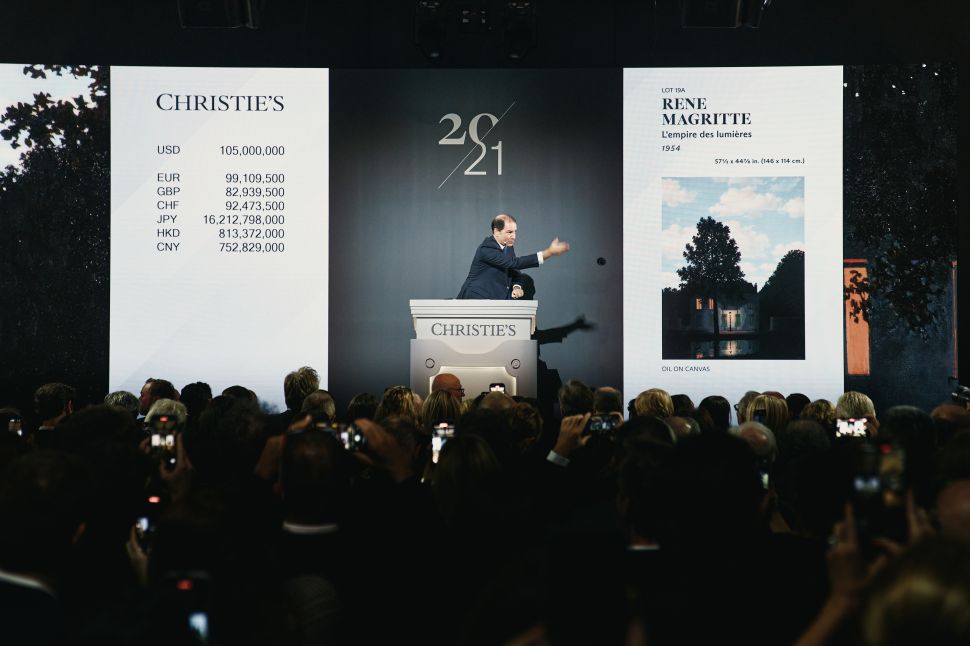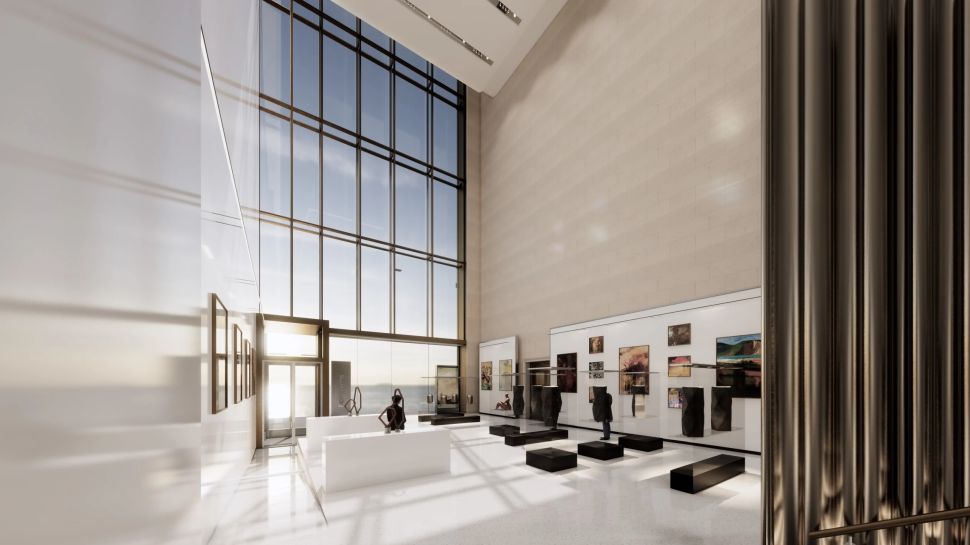
The year 2024 closed on a less-than-glamorous note for the big three auction houses, capping a challenging stretch that underscored a noticeable slowdown in the market’s pace. With the secondary market and auctions undergoing what analysts generously call a “reset”—others might say “correction”—it’s clear the fireworks that once defined ultracontemporary art sales have dimmed to a flicker. Against a backdrop of geopolitical turbulence and financial market volatility, buyer confidence took a hit, leaving auction houses grappling with an uphill battle to secure top-tier consignments and blockbuster collections. Resilience is the word of the moment, but much of the action in 2024 skewed toward the lower end of the market, a far cry from the high-octane bidding wars of recent years.
Still, not all was gloom and doom. Sparks of brilliance appeared in the fall, with Sotheby’s scoring a notable success thanks to the Sydell Miller collection, which totaled $215.6 million. Leading the charge was Monet’s iconic Waterlilies, commanding a solid $65.5 million. But even this achievement was overshadowed by Christie’s headline-making $121.2 million hammer price for Magritte’s Empire of Lights, the crown jewel of the Mica Ertegun collection, which pulled in a hefty $196.1 million overall. These standout sales served as rare highlights in a market that otherwise saw its November auctions in New York plunge 40 percent year-over-year—a stark indicator of the broader cooling taking place across New York, London and Hong Kong.
As we step into 2025 and a fresh auction season begins, the question looms: can the major houses turn the tide? Observer examined how the world’s biggest auction houses closed the year and whether they can hope for a better 2025.
A year of changes and challenges for Sotheby’s
The most glaring indication that 2024 wasn’t a banner year for Sotheby’s—or the auction business as a whole—came in December when the auction house laid off over 100 employees in a cost-cutting move. While Sotheby’s final earnings for the year should be published later this month, the September report painted a grim picture: revenues for the first half of 2024 were down 22 percent, to $558.5 million. Even the $700 million investment from Abu Dhabi’s Sovereign Wealth Fund, secured earlier in the year, largely went to chipping away at Patrick Drahi’s staggering $60 billion debt load. While there’s been much speculation about Sotheby’s intentions in the Gulf, the auction house has no immediate plans to significantly expand its presence in the region. That said, its first multi-category auction in Saudi Arabia is set for February in Diriyah, just outside Riyadh—a notable move but not exactly a sea change.
Despite the headwinds, Sotheby’s spent 2024 leaning into expansion on other fronts. The auction house revamped its headquarters in Hong Kong and Paris, turning them into glitzy luxury boutiques aimed at luring deep-pocketed younger clients and extending its brand beyond traditional auctions. Now, Sotheby’s is preparing for its most ambitious move yet: taking over the iconic Met Breuer building in New York, a deal that closed for $100 million. The new headquarters promises to blur the lines between museum, high-end retail and the traditional auction model, a hybrid approach designed to captivate today’s affluent, experience-hungry clientele.
Meanwhile, 2024’s financial challenges forced Sotheby’s to walk back its ambitious overhaul of fee structures introduced in May. The original plan—a flat 20 percent buyer’s premium (dropping to 10 percent for works over $6 million) and a 10 percent fixed seller’s fee capped at $50,000—was designed to simplify transactions and attract buyers. However, from February 17, Sotheby’s will revert to its previous tiered structure: a 27 percent premium for works up to $1 million, 22 percent for those between $1 million and $8 million, and 15 percent above $8 million. Seller fees will also once again be individually negotiated. These adjustments bring Sotheby’s fees more in line with its rival, Christie’s, which charges a 26 percent premium up to $1 million, 21 percent from $1,000,001 to $6,000,000 and 15 percent above $6 million. While these moves may steady the ship, they underline the uphill climb Sotheby’s faces in a recalibrating market.

Christie’s resilience and resolutions for a new year
In releasing the auction house’s fourth-quarter results on December 17, Christie’s CEO Guillaume Cerutti candidly acknowledged the “challenging environment for the art market,” as evidenced by a 16 percent decline in the auction house’s total sales for 2024. Despite the drop, Christie’s managed to net a not-insubstantial $4.2 billion, buoyed by an impressive $1.5 billion in privately brokered deals—up from $1.1 billion last year and marking the second-highest private sales total since 2020. Across live, online and private sales, the total came to $5.7 billion, reflecting a smaller decline compared to the previous year’s 26 percent slump and signaling a slow but ongoing market recovery. Other indicators, such as a hammer price index of 112 percent and an 86 percent sell-through rate, suggested incremental improvements over 2023.
A bright spot for Christie’s was the growing engagement of Millennials and Gen Z collectors, who accounted for 30 percent of total bidders and buyers, contributing a $1.2 billion total in bought and underbid value. This demographic shift offers a promising path for future growth, reflecting a new generation’s rising influence in the art market.
The new year started on a high note with the fortuitous rediscovery of a watercolor by J.M.W. Turner, The Approach to Venice, submitted through Christie’s “Request an Estimate” online appraisal service. This work will headline the Old Master and British Drawings Sale in New York on February 4 with an estimate of $300,000 to $500,000. Upcoming highlights also include a group of unique clothing items and accessories from America’s style icon Iris Apfel, offered online, and a live auction on February 13 in London showcasing the collection of Australian performer Barry Humphries. The Humphries sale will feature 19th-century European and Symbolist art by artists like Fernand Khnopff, Jean Delville and Franz von Stuck, alongside Impressionist and Modern British art, modern design and an astonishing trove of Oscar Wilde-related material.
In a LinkedIn post outlining priorities for 2025, Cerutti emphasized Christie’s commitment to environmental sustainability through the Science-Based Targets Initiative, ensuring alignment with the Paris Agreement. He also highlighted goals for expanding access and growth, both regionally and in scope, “beyond its usual boundaries.” Cerutti cited Art Landing as a successful example of diversification and noted the auction house’s ongoing exploration of the intersection between art and technology, as well as synergies between the art market and luxury goods industries—a trend echoed in Sotheby’s strategy.
Christie’s is also making inroads in the Gulf region, securing a commercial license to operate in Saudi Arabia and appointing Nour Kelani as head of client services in the kingdom. The auction house recently opened its new Asia Pacific headquarters in Hong Kong’s Henderson building, a striking skyscraper designed by Zaha Hadid Architects. However, the inaugural evening sale at the new venue revealed some caution among local collectors, with adjusted prices and conservative bidding ultimately netting HK$883.1 million ($113.4 million).




Phillips’s game of musical chairs and drastic reduction of ultracontemporary
The other major news in December was the announcement that auction veteran Ed Dolman would step down from his role as Phillips’s CEO and executive chairman, passing the torch to Martin Wilson, an art lawyer and current chair of the British Art Market Federation. Dolman, who will remain in an advisory role until May to assist with the transition, is departing alongside Amanda Lo Iacono, who was appointed deputy CEO earlier in the year but has also since left the company. This leadership shake-up follows the resignation of Stephen Brooks in January after a three-year tenure, marking the second major change at Phillips’s helm in less than a year—a clear reflection of the ongoing challenges in the company’s management and finances.
Dolman leaves behind a notable legacy. Over his ten-year tenure, he guided Phillips through significant growth, with total sales skyrocketing from $398 million in 2014 to $1 billion in 2023. He also positioned the auction house ahead of its competitors by opening a Hong Kong headquarters before Christie’s and Sotheby’s made their moves. Under his leadership, Phillips expanded its global reach and digital capabilities, carving out a niche in the ultracontemporary art market during its pandemic-era boom.
However, 2024 proved a difficult year for Phillips. Revenues and sell-through rates declined across categories, with notable struggles in its modern and contemporary art segments. The fall evening sales of modern and contemporary art brought in $54.1 million, a sharp drop from the $69.9 million achieved in 2023. Of the thirty-three lots cataloged for the evening sale, one-third performed below expectations, three were withdrawn before the sale and four failed to sell, resulting in a modest 83 percent sell-through rate.
The steep decline in ultracontemporary art sales has hit Phillips particularly hard, given its dominance in this segment during the pandemic’s frothy market. According to Artnet’s The Intelligence Report Mid-Year Review, values for ultracontemporary works fell by 39 percent from 2023 to 2024. Phillips responded by scaling back its offerings in this category, with the total value of ultracontemporary items auctioned dropping 50 percent from the $1.12 million reached last year.
Bonhams progressive growth
In a shifting auction market landscape, London’s venerable auction houses, many tracing their origins back to 1793, have seen a surge in relevance in recent years. Bonhams, in particular, has capitalized on this momentum, leveraging its acquisition by British private equity firm Epiris and a series of leadership changes to execute an ambitious growth strategy. The company has expanded its reach by acquiring several regional auction houses, including Bukowskis in Stockholm, Bruun Rasmussen in Copenhagen, Skinner in Boston, and Cornette de Saint Cyr in Paris. Bonhams closed 2023 with a record-breaking $1.14 billion in revenue, the highest in its history, and now operates an impressive 14 global salesrooms.
In a move that underscores the blending of the auction and luxury markets, Bonhams appointed Chabi Nouri as its global CEO last summer. With years of experience in the luxury industry, Nouri’s leadership reflects the auction house’s strategic push to adopt the skills and approaches of high-end retail and luxury brands. This pivot aims to attract a broader and more diverse clientele while positioning Bonhams as a key player in the evolving international luxury market. Further cementing its U.S. presence, Bonhams plans to relocate its New York headquarters in late 2025, leaving 580 Madison Avenue for the iconic Steinway Hall at 111 West 57th Street—a move that reflects its growth in the American market, bolstered by a coast-to-coast presence and the acquisition of Bonhams Skinner in New England.
Bonhams has also been strengthening its foothold in Asia, joining its rivals with the November opening of a flagship location in Hong Kong at Six Pacific Place. This follows an impressive 33 percent year-over-year growth in its Hong Kong Spring Sales season, which netted HK$270 million (US$35 million). Recently, Bonhams announced that its Hong Kong sales for 2024 surged by 18 percent, reaching HK$670 million (US$86 million)—its highest total since establishing a presence in the city in 2017.




For those wondering what the year ahead holds for buyers, the latest Bank of America (BAC) Art Market Update offered a cautiously optimistic outlook for art auction sales in 2025, even as the road ahead remains anything but smooth for the major auction houses. With the market still undergoing adjustment and price recalibration, these institutions face the challenge of navigating strategic use of guarantees, setting cautious estimates and carefully negotiating with both buyers and sellers to secure top-quality consignments. The balancing act requires a delicate touch as they aim to maintain momentum in a market marked by uncertainty. Simultaneously, auction houses are looking beyond traditional sales to explore alternative business opportunities in emerging regions and, perhaps even more critically, at the intersection of the art market and luxury retail. This strategic pivot reflects a clear effort to engage new generations of wealthy buyers, aligning their offerings with the tastes and expectations of younger, affluent demographics.
This post was originally published on this site be sure to check out more of their content





